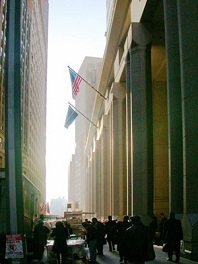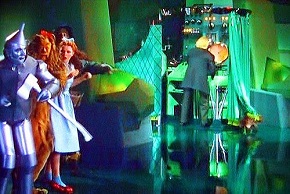Pulling Back the Curtain on the Wall Street Money Machine
We have been distracted here and in Europe by a sudden panic over our “sovereign debt” crises, when the real crisis is that our debt is NOT sovereign.
On November 27, Bloomberg News reported the results of its successful case to force the Federal Reserve to reveal the lending details of its 2008-09 bank bailout. Bloomberg reported that by March 2009, the Fed had committed $7.77 trillion in below-market loans and guarantees to rescuing the financial system; and that these nearly interest-free loans came without strings attached.
The Fed insisted that the loans were repaid and there have been no losses, but the Bloomberg report said the banks reaped a $13 billion windfall in profits; and “details suggest taxpayers paid a price beyond dollars as the secret funding helped preserve a broken status quo and enabled the biggest banks to grow even bigger.”
The revelations provoked shock and outrage among commentators. But in a letter to the leaders of the House and Senate Committees focused on the financial services industry, Fed Chairman Ben Bernanke responded on December 6th that the figures were greatly exaggerated. He said the loans were being double-counted: short-term loans rolled over from day to day were counted as separate cumulative loans rather than as a single extended loan.
The Fed, it seems, was doing only what banks and the money market do for each other every day: making “liquidity” available at very low interest rates. In 2008, bank liquidity dried up after Lehman Brothers collapsed, and the banks could not get the cheap, ready credit on which their lending scheme depends. The Fed then stepped in as “lender of last resort,” doing what it had to do to keep the banking scheme going.
Keeping the banking system afloat is all well and good. What is wrong with the existing scheme is that it allows the Fed to play favorites.
As Alan Grayson observed in a December 5th editorial:
The main, if not the sole, qualification for getting help from the Fed was to have lost huge amounts of money. The Fed bailouts rewarded failure, and penalized success...
During all the time that the Fed was stuffing money into the pockets of failed banks, many Americans couldn’t borrow a dime for a home, a car, or anything else. If the Fed had extended $26 trillion in credit to the American people instead of Wall Street, would there be 24 million Americans today who can’t find a full-time job?
All in the Name of Liquidity
What is this need for “liquidity” that justifies such extraordinary measures on behalf of the banks? Why do banks need cheap and ready access to funds? Aren’t they the lenders rather than the borrowers of funds? Don’t they simply take in deposits and lend them out?
The answer is no. Today when banks make loans, they extend credit FIRST, then fund the loans by borrowing from the cheapest available source. If deposits are not available, they borrow from another bank, the money market, or the Federal Reserve.
Rather than loans being created from deposits, loans actually CREATE deposits. They create deposits when checks are drawn on the borrower’s account and deposited in another bank. These deposits can then be borrowed back at the Fed funds rate—currently a very low 0.25%. A bank can thus create money in the form of “bank credit,” lend it to a customer at high interest, and borrow it back at very low interest, pocketing the difference as its profit.
If all this looks like sleight of hand, it is. The process has been compared to “check kiting,” defined in Barron’s Business Dictionary as:
[An] illegal scheme that establishes a false line of credit by the exchange of worthless checks between two banks. For instance, a check kiter might have empty checking accounts at two different banks, A and B. The kiter writes a check for $50,000 on the bank A account and deposits it in the bank B account. If the kiter has good credit at bank B, he will be able to draw funds against the deposited check before it clears, that is, is forwarded to bank A for payment and paid by bank A. Since the clearing process usually takes a few days, the kiter can use the $50,000 for a few days and then deposit it in the bank A account before the $50,000 check drawn on that account clears.
Setting Things Right

As suspicious as all this appears, the economy actually needs an expandable credit system, and an expandable credit system needs a lender of last resort. What is wrong with the current scheme is that it discriminates against Main Street in favor of Wall Street. Banks can borrow very cheaply, while individuals, corporations and governments pay “whatever the market will bear.” The banker middlemen take their cut in a scheme in which money is actually manufactured in the process of lending it. The profits are siphoned off to the 1% at the expense of the 99%.
To fix the system, the profits need to be returned to the 99%. How that could be done was suggested by Thom Hartmann in a recent editorial:
Have the central bank owned by the US government and run by the Treasury Department, so all the profits...go directly into the Treasury and you and I pay less in taxes...
For a model on the local level, he pointed to the Bank of North Dakota:
The good people of North Dakota...established something very much like this—the Bank of North Dakota—and it’s kept the state in the black, and kept its farmers, manufacturers and students protected from the predations of New York banksters for nearly a century. It’s time for every state to charter their own state bank, just like North Dakota did, and for the Treasury Department to either buy the Fed from the for-profit banks that own it, or simply nationalize it.
We have been distracted here and in Europe by a sudden panic over our “sovereign debt” crises, when the real crisis is that our debt is NOT sovereign. We are indentured to a Wall Street money machine that creates our money and lends it back to us at interest, money our sovereign government could be creating itself, with full democratic oversight and accountability to the people. We have forgotten our roots, when the American colonists thrived on a system of money created by the people themselves, debt-free and interest-free. The continued dominance of the Wall Street money machine depends on that collective amnesia. The fact that this memory is surfacing again may be the machine’s greatest threat—and our greatest hope as a nation.
___________________________________________________________________________________
Ellen Brown developed her research skills as an attorney practicing civil litigation in Los Angeles. In Web of Debt: The Shocking Truth About Our Money System and How We Can Break Free (2010), her latest of eleven books. She turns those skills to an analysis of the Federal Reserve and “the money trust.” She shows how this private cartel has usurped the power to create money from the people themselves, and how we the people can get it back. She also is president of the Public Banking Institute. Her websites are www.webofdebt.com, www.ellenbrown.com, and www.public-banking.com.
___________________________________________________________________________________
Article published here: Web of Debt Blog
URL: http://www.a-w-i-p.com/index.php/2011/12/08/pulling-back-the-curtain-on-the-wall-str

























